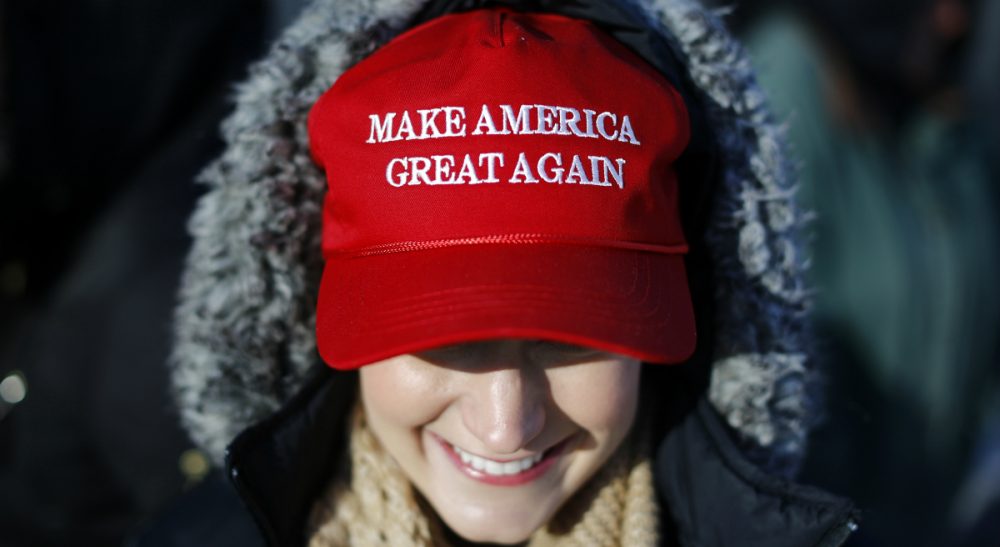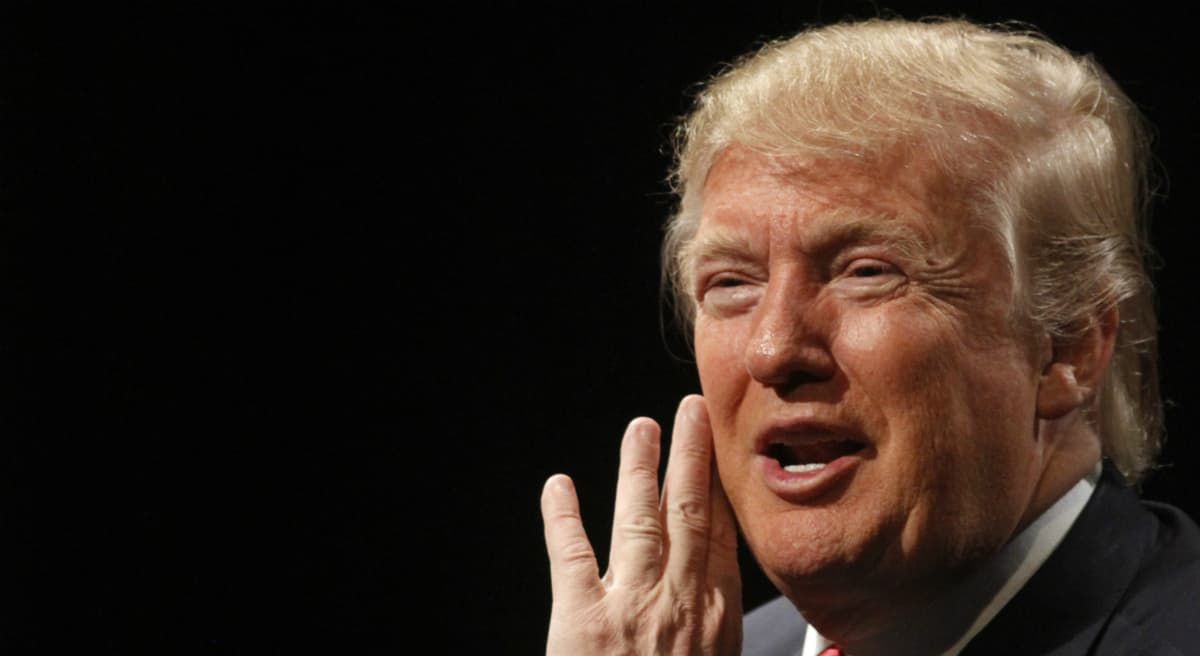Advertisement
Trump Wants To 'Make America Great Again,' But What Does That Really Mean?

“Make America Great Again” is the driving refrain of Donald Trump’s presidential campaign, the title of two Trump-authored books as well. Few would have a problem with the first three words. But it is that fourth — “again” -- that raises hackles.
Amusingly, Trump actually trademarked the slogan. According to the U.S. Patent and Trademark Office, one Donald J. Trump, an individual at 725 Fifth Avenue in New York, has the right to “Make America Great Again” for “political action committee services” as well as “fundraising in the field of politics.”
Even better, Trump — ever the marketer -- also has the merchandising rights. He owns the right to use “Make America Great Again” on “all-purpose athletic bags; all-purpose carrying bags; backpacks; beach bags; book bags; carry-all bags; change purses” and so on. Even on “pet clothing.” If it can be worn, Trump has it locked up.
Trump -- ever the marketer -- also has the merchandising rights. He owns the right to use 'Make America Great Again' on 'all-purpose athletic bags...' Even on 'pet clothing.' If it can be worn, Trump has it locked up.
There’s much dispute over Trump’s legal appropriation of a phrase that one would have expected many pols to light upon. Indeed, Ronald Reagan used the slogan before, in his successful 1980 race against Jimmy Carter. Reagan, however, apparently wasn’t clever enough to trademark it — either that, or he was insufficiently mercenary. As The Donald doubtless would point out, that’s why he’s a billionaire and the rest of us aren’t.
Ownership rights aside, a substantive question should be asked: Is Trump right? Saying “let’s make America great again” implies that it is not great now. It implies as well that there was a time when it was great — or at least, better than it is today.
The nation is 240 years old; the Constitution itself, 228. The ideals of the United States were best expressed in the 1776 Declaration of Independence: “that all men are created equal, that they are endowed by their Creator with certain unalienable Rights, that among these are Life, Liberty and the pursuit of Happiness.” The Constitution was created to make those ideals reality (indeed, the Declaration was explicit in that: “to secure these rights, Governments are instituted among Men”).
So in the two-plus centuries since, how have we been doing?
Our ideals were laudable, but we began badly. The Constitution explicitly acknowledged slavery and counted slaves as less than human — a fault not remedied until the post-Civil War amendments. Women weren’t allowed to vote either — a fault finally fixed by the 19th Amendment in 1920.

Indeed, one doesn’t have to be an acolyte of the leftist historian Howard Zinn to recognize that the full benefits of citizenship in the U.S. were for a long time confined to the very few: For the most part, you had to be male, white, straight, propertied, educated, not a recent immigrant and also (as Native Americans could testify) not an immigrant from long, long ago.
Much of that, of course, has changed. Indeed, the story of America is very much the story of our growing understanding that everyone is entitled to those “certain unalienable rights.” Sometimes that’s happened through amendment, other times through legislation, court decisions or simply — and most powerfully — through changing attitudes. Fifty, 25 or even 10 years ago, it’s hard to imagine women, African-Americans, gay folks or any number of other minorities thinking America was great for them — or at least, it’s hard to imagine them now thinking that yesterday’s world afforded them more in the way of opportunities than today’s.
And in fact, there’s strong data available to support the notion that opportunity in America — and opportunity is at the core of the American Dream — is better than it ever was. Opportunity Nation -- a bipartisan project that has tried for the last five years to quantify the opportunity available to Americans — has just released its most iteration of what it calls the “Opportunity Index.” The numbers are encouraging.
The index scores opportunity numerically. On the national level, it concludes that opportunity has improved 8.9 percent from 2011 to 2015. (Back then, the score was 49.6; nowadays it’s 54.0. The numbers — like the Dow Jones Industrial Index — don’t tell you much, except that higher is better.) The index goes into detail too, measuring opportunity state-by-state and even county-by-county.
Vermont, it turns out, ranks first. Massachusetts is a close second. Much of the South is well down in the rankings; New Mexico is dead last.
Trump’s slogan is ultimately pessimistic, bemoaning our times as so much worse than before, nostalgically looking back to some misremembered golden age in America. But that’s not reality.
Why the differences? The index looks at three broad measures: the local economy, education, and community health (a catch-all that includes everything from crime rates to access to health care). The basic argument is that strong economies, decent education and safe and secure communities add up to opportunity for everyone. Massachusetts does well because it has low unemployment and one of the best educational systems in the nation (yes, really — the Bay State consistently gets top grades in the National Assessment of Education Progress, the so-called “Nation’s Report Card”). New Mexico, on the other hand, is hurt by its high poverty and poor rates of high-school graduation.
There are two key conclusions to draw from the index. First, although the index doesn’t contain data from before 2011, yet it seems clear that if it attempted that exercise, the level of opportunity in recent times would prove far better than they were in years past. The reason is straightforward: Opportunity for some is not opportunity for all.
The second is that opportunity is something that’s within our control. Almost every factor that the index looks at is affected in part by public policy at the federal, state and local levels, including items such as preschool enrollment, access to grocery stores and affordable housing. Get those right, and we make the American Dream ever more attainable.
Trump’s slogan is ultimately pessimistic, bemoaning our times as so much worse than before, nostalgically looking back to some misremembered golden age in America. But that’s not reality. We’re better now than we ever have been. And we have it in our hands to make the years ahead better still.
